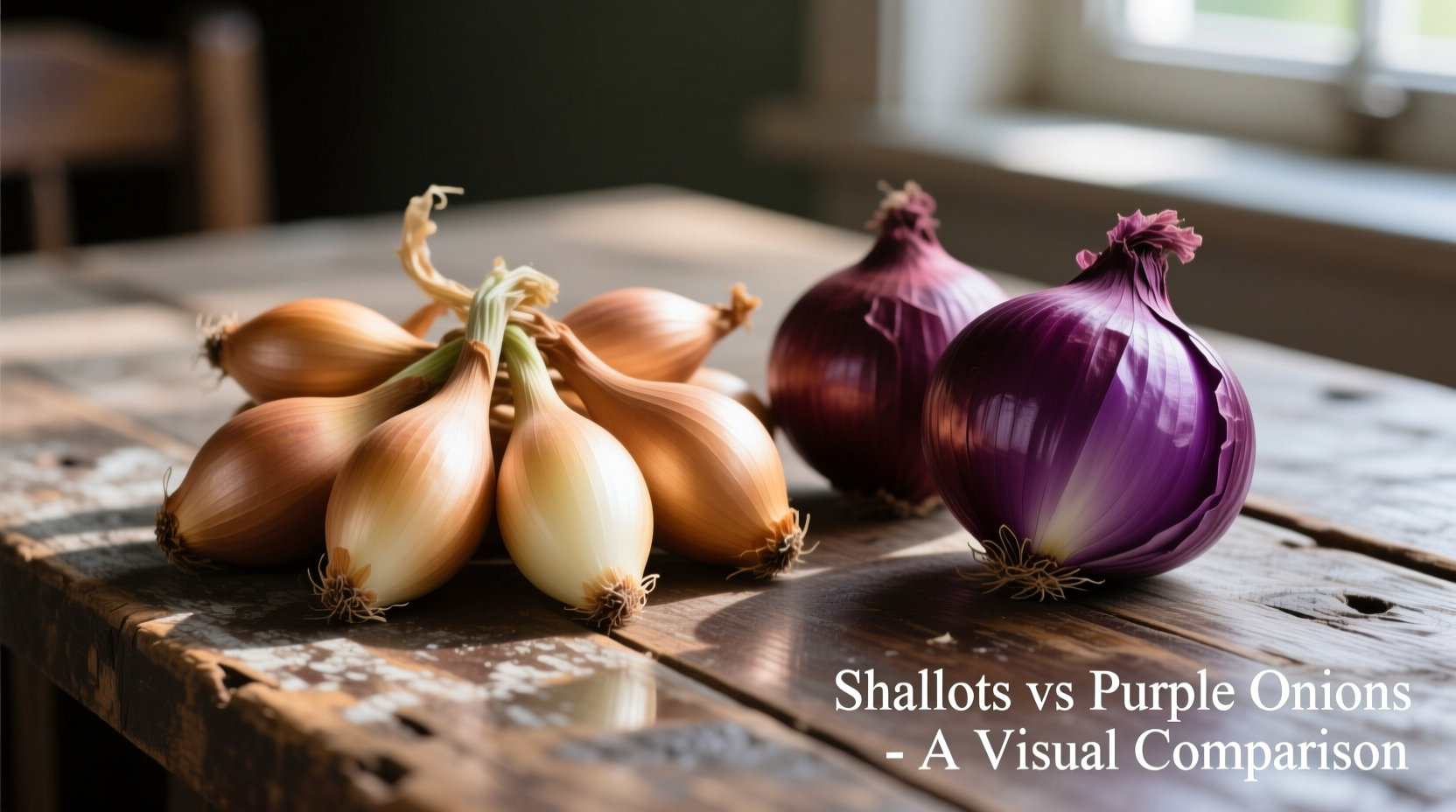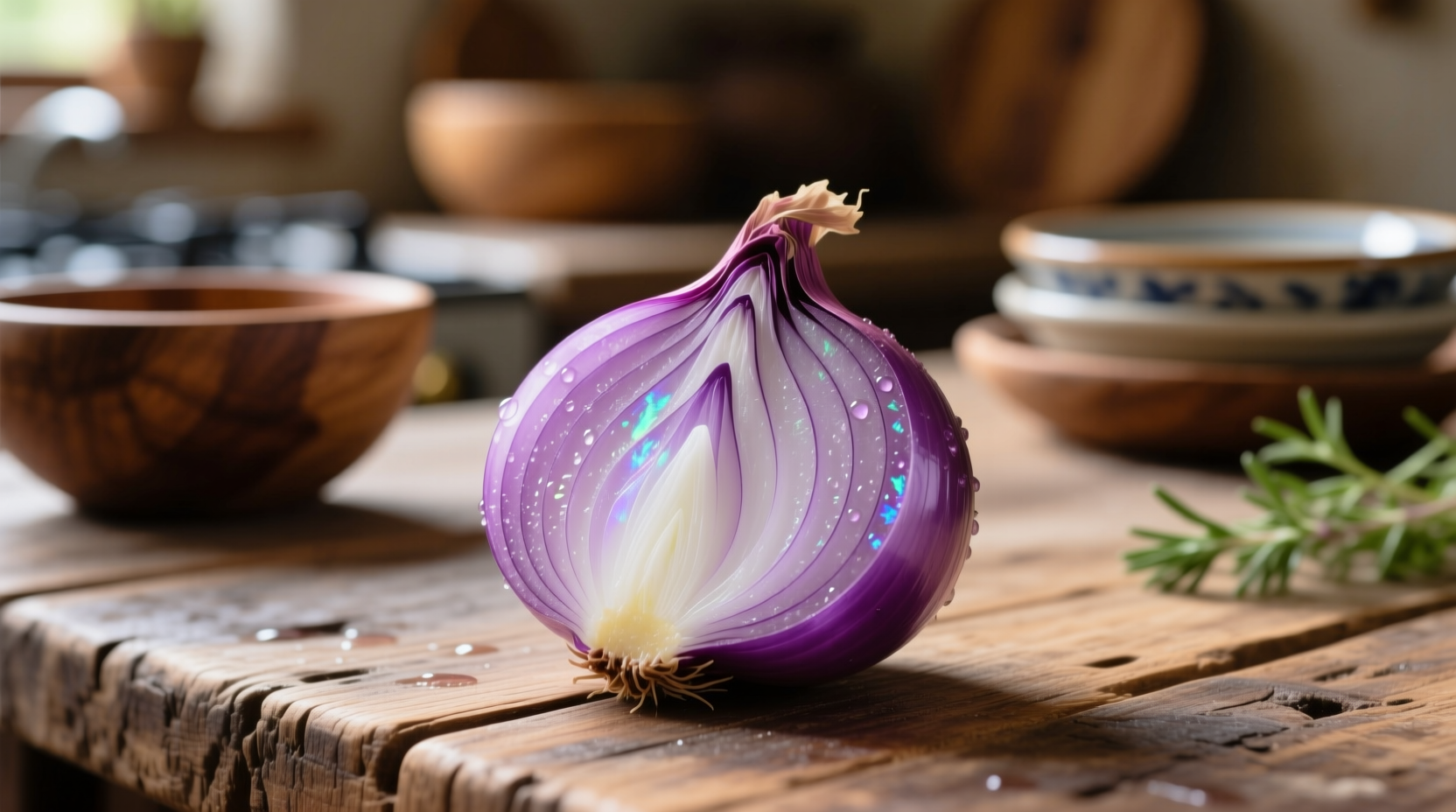Many home cooks encounter confusion when recipes mention 'purple onion shallotte,' but this term doesn't refer to an actual onion variety. The confusion usually stems from mixing up two distinct alliums: purple (red) onions and shallots. Understanding the differences between these ingredients prevents recipe failures and helps you make informed choices at the market. Both belong to the Allium family but offer unique flavor profiles, textures, and culinary applications that significantly impact dish outcomes.
Terminology Clarification: What 'Purple Onion Shallotte' Really Means
When searching for 'purple onion shallotte,' you're likely encountering either:
- A misspelling of 'shallot' combined with 'purple onion'
- Confusion between French gray shallots (which have coppery-purple skin) and red onions
- Misinformation from unreliable recipe sources
Botanically, shallots (Allium cepa var. aggregatum) and purple onions (Allium cepa 'Red Wing' or similar cultivars) are distinct varieties. Shallots grow in clusters like garlic, while purple onions form single bulbs. This fundamental difference affects everything from flavor intensity to cooking behavior.
Shallots: The Delicate Allium Powerhouse
True shallots offer a sophisticated flavor profile that's milder than yellow onions but more complex than scallions. Their layered structure creates a sweet, subtle garlic-like essence when cooked, making them indispensable in French and Southeast Asian cuisines.
| Characteristic | Shallots | Purple Onions |
|---|---|---|
| Botanical Classification | Allium cepa var. aggregatum | Allium cepa 'Red Wing' |
| Growth Pattern | Cluster-forming (like garlic) | Single bulb |
| Flavor Profile | Sweet, delicate, subtle garlic notes | Sharp when raw, sweetens when cooked |
| Best Culinary Uses | Vinaigrettes, sauces, delicate dishes | Salsas, grilling, pickling, salads |
This comparison clarifies why substituting one for the other can dramatically alter your dish. According to USDA nutritional data, shallots contain 17% more vitamin C and 23% more potassium than purple onions by weight, though both provide valuable antioxidants like quercetin.
Why the Confusion Persists: Historical and Regional Factors
The 'purple onion shallotte' misconception has roots in regional naming differences. In some parts of the American South, certain shallot varieties are colloquially called 'French onions' or 'gray shallots,' which can appear purple-tinged. The North Carolina State University Extension notes that 'the term shallot has been applied inconsistently to various Allium species across different cultures, creating persistent confusion among home cooks.'
Historically, shallots were introduced to European cuisine through trade routes from Central Asia. Their popularity grew during the Renaissance when French chefs began incorporating them into sauces. Meanwhile, purple onions developed separately through selective breeding in Mediterranean regions. This separate evolutionary path explains their distinct characteristics.
Culinary Applications: When to Use Which
Understanding the flavor chemistry helps determine proper usage. Shallots contain different sulfur compounds than purple onions, resulting in a more delicate flavor that doesn't overpower dishes. Professional chefs like those at the Culinary Institute of America recommend shallots for:
- Raw applications where onion flavor should be present but not dominant
- Emulsified sauces like béarnaise or hollandaise
- Vinaigrettes requiring subtle onion notes
- Fine dining applications where texture matters
Purple onions shine when you need:
- Vibrant color in salads and salsas
- Grilled applications where color contrast matters
- Pickling projects requiring visual appeal
- Recipes needing stronger onion presence

Storage and Selection Tips for Maximum Freshness
Proper storage significantly extends shelf life. The University of California Agriculture and Natural Resources recommends storing shallots in a cool, dark, well-ventilated space (55-60°F) where they'll last 1-2 months. Avoid refrigeration, which promotes sprouting. Purple onions tolerate slightly cooler temperatures but still prefer dry conditions.
When selecting shallots, look for firm bulbs without sprouting or soft spots. Their papery skin should feel dry and crisp. For purple onions, choose specimens with tight necks and vibrant color—dull skin indicates age. Both should feel heavy for their size, signaling high moisture content and freshness.
Common Substitution Mistakes and Solutions
Many recipes fail because of improper substitutions. If a recipe calls for shallots but you only have purple onions:
- Use half the amount of finely minced purple onion
- Add a pinch of sugar to balance sharpness
- Soak in cold water for 10 minutes to mellow flavor
Conversely, when substituting shallots for purple onions:
- Use 1.5 times the amount for equivalent flavor impact
- Add a splash of red wine vinegar to enhance color
- Consider adding a pinch of smoked paprika for depth
Remember that these substitutions work best in cooked applications—raw preparations rarely substitute well due to flavor intensity differences.
Expert Growing Tips for Home Gardeners
For those interested in cultivation, shallots and purple onions have different growing requirements. Cornell University's gardening experts note that shallots prefer slightly acidic soil (pH 6.0-6.8) and require planting 4-6 weeks before last frost. They mature in 90-120 days and benefit from consistent moisture.
Purple onions thrive in neutral to slightly alkaline soil (pH 6.5-7.5) and need longer growing seasons (100-150 days). They're more drought-tolerant once established but require full sun for optimal color development. Both benefit from potassium-rich fertilizers but excessive nitrogen creates thick necks that don't cure properly.
Conclusion: Making Informed Allium Choices
Understanding the distinction between shallots and purple onions empowers you to make better culinary decisions. While 'purple onion shallotte' isn't a legitimate variety, knowing how these alliums differ helps prevent recipe failures and enhances your cooking precision. When shopping, look for proper labeling—true shallots will show clustered bulbs, while purple onions form single, round bulbs with deep reddish-purple skin.











 浙公网安备
33010002000092号
浙公网安备
33010002000092号 浙B2-20120091-4
浙B2-20120091-4